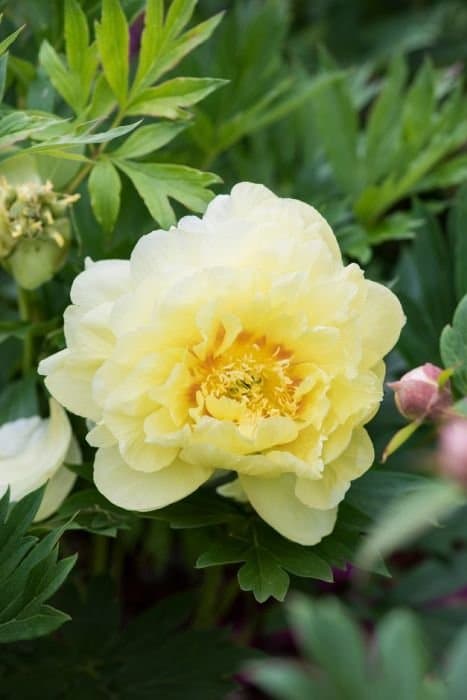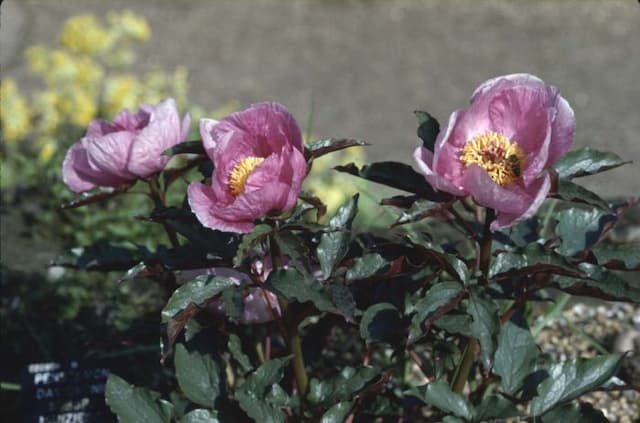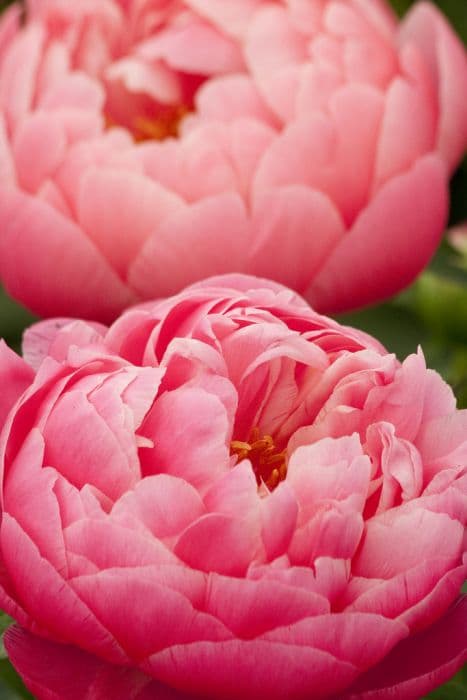Chinese peony Paeonia lactiflora 'Nancy Nora'

ABOUT
The 'Nancy Nora' peony is a stunning perennial plant known for its large, showy flowers. These blooms exhibit a soft pink color that can range from a pale, almost blush shade to a more pronounced pink hue, depending on various factors. The petals are typically arranged in a full, rounded shape, giving the peony its classic, opulent appearance. At the center of the flowers, you can often find a cluster of yellow stamens that provide a delightful contrast against the pink petals, adding allure to the bloom's overall aesthetics. The foliage of the 'Nancy Nora' peony is equally appealing, with deep green leaves that have a lustrous, somewhat leathery texture. The leaves are divided into segments, which are further divided into a shape that resembles an elegant feather, lending a lush, verdant backdrop to the glorious flowers. As the plant goes through the blooming season, the flowers may attract various pollinators, adding movement and life to the garden. After the blooming period, the peony's petals will typically fade and fall, leaving behind the foliage which remains attractive throughout the growing season until frost. The 'Nancy Nora' peony is esteemed for its captivating blooms, elegant foliage, and its contribution to creating a classic and romantic garden atmosphere.
About this plant
 Names
NamesFamily
Paeoniaceae
Synonyms
Chinese Peony, Common Garden Peony
Common names
Paeonia lactiflora.
 Toxicity
ToxicityTo humans
Peony, including the variety Paeonia lactiflora 'Nancy Nora', is generally considered non-toxic to humans. There is no documented evidence of severe poisoning in humans from ingesting peonies. However, it is always advised to keep an eye on children around plants and to avoid ingesting any part of ornamental plants as a precaution.
To pets
Peony, which includes the Paeonia lactiflora 'Nancy Nora', may cause mild gastrointestinal upset if ingested by pets, particularly cats and dogs. Symptoms of peony poisoning in pets could include vomiting, diarrhea, and drooling. While toxicity is generally considered low, if a pet exhibits persistent signs after ingesting peonies, it is advisable to consult a veterinarian.
 Characteristics
CharacteristicsLife cycle
Perennials
Foliage type
Deciduous
Color of leaves
Green
Flower color
Pink
Height
2-3 feet (60-90 cm)
Spread
2-3 feet (60-90 cm)
Plant type
Herb
Hardiness zones
3-8
Native area
Asia
Benefits
 General Benefits
General Benefits- Ornamental Appeal: Paeonia lactiflora 'Nancy Nora', commonly known as Chinese peony, is highly valued for its large, fragrant flowers that can add aesthetic beauty to gardens and landscapes.
- Longevity: Chinese peonies are known for their long lifespan, often thriving for decades in the same location when cared for properly.
- Cut Flower Use: The blooms of the Chinese peony make excellent cut flowers, holding up well in vases and floral arrangements.
- Seasonal Interest: In addition to their spring blooms, Chinese peonies offer attractive foliage throughout the growing season, contributing to the garden's seasonal interest.
- Pollinator Attraction: The flowers can attract bees and other pollinators, supporting local ecosystems and biodiversity.
- Low Maintenance: Once established, Chinese peonies require minimal maintenance, making them suitable for gardeners seeking low-maintenance plants.
- Drought Tolerance: Though they prefer well-watered soil, Chinese peonies can tolerate periods of drought.
- Cold Hardy: Chinese peonies are relatively cold hardy, making them suitable for gardens in cooler climates.
 Medical Properties
Medical Properties- Antioxidant - Peony root extract is known to contain compounds with antioxidant properties.
- Anti-inflammatory - Traditionally used for reducing inflammation in various conditions.
- Immunomodulatory - May influence immune system function favorably, though specific effects are not well-defined.
- Analgesic - Peony preparations have been used to alleviate pain in some traditional medicinal systems.
- Antispasmodic - Can be used to relieve muscle spasms or cramping, as per traditional herbal medicine practices.
 Air-purifying Qualities
Air-purifying QualitiesThis plant is not specifically known for air purifying qualities.
 Other Uses
Other Uses- Cut Flowers: Peony 'Nancy Nora' blooms are highly regarded for their aesthetic appeal and are often used in floral arrangements and bouquets due to their size, color, and fragrance.
- Art and Photography: The striking appearance of the peony flowers makes them a popular subject for artists and photographers.
- Feng Shui: In the practice of Feng Shui, peonies are considered to symbolize wealth, good fortune, and prosperity, and are thus used in home decor for these purposes.
- Perfume Production: The fragrant scent of peony 'Nancy Nora' can be captured and used in the manufacture of scented perfumes.
- Garden Aesthetics: Their lush foliage and beautiful blooms make them a focal point in garden designs, contributing significantly to the overall aesthetic.
- Special Events Decoration: Peonies are widely used in decor for weddings and other special events as a symbol of romance and prosperity.
- Crafting: Dried peony petals can be used in crafting, for instance in the making of natural potpourri blends or in paper making.
- Edible Flowers: While not commonly known for this use, the petals of peony 'Nancy Nora' are edible and can be used in salads or as a garnish to add a splash of color to dishes.
- Religious Ceremonies: In some cultures, peonies are used as offerings or decorations during religious ceremonies as symbols of honor and riches.
- Culinary Decoration: The flowers and petals can be crystallized and used as elegant, edible decorations on cakes and pastries.
Interesting Facts
 Feng Shui
Feng ShuiThe most common common name for Paeonia lactiflora 'Nancy Nora' is Peony. In Feng Shui, the Peony is considered a symbol of wealth, prosperity and is used to attract romantic love. It's often recommended to place Peonies in the Love & Marriage area of your home or garden to enhance relationships and romance.
 Zodiac Sign Compitability
Zodiac Sign CompitabilityThe Peony is not used in astrology practice.
 Plant Symbolism
Plant Symbolism- Prosperity: Peonies like Paeonia lactiflora 'Nancy Nora' commonly symbolize prosperity due to their full, rounded blooms that resemble coins, which in many cultures represent wealth and success.
- Beauty: With their large, lush petals and strong fragrance, peonies are often associated with beauty in both the physical and spiritual sense, representing an ideal form of aesthetics.
- Romance: Peonies are traditionally linked to romance and romantic love, often found in bridal bouquets and wedding decorations to wish newlyweds happiness and a loving marriage.
- Honor: They are also symbols of honor and high value, reflecting the respect and admiration one might have for another person.
- Femininity: The delicate and ornate nature of peonies resonates with traditional symbols of femininity, conveying grace and gentleness.
- Good Luck: In some cultures, peonies are believed to bring good luck and positive outcomes, making them a favored gift for new beginnings and ventures.
- Healing: Historically, peonies have also been associated with healing, both emotional and physical, as they were used in traditional medicines and remedies.
 Water
WaterPeonies, such as the 'Nancy Nora', should be watered deeply once a week, providing about 1 inch of water which is equivalent to approximately 0.6 gallons per square yard. In periods of drought or extreme heat, watering frequency may increase to twice a week. It is essential to avoid overhead watering to prevent fungal diseases; instead, water at the soil level to reach the roots directly. During the fall, reduce watering as the plant prepares for dormancy. In winter, watering is typically not necessary unless the soil is very dry and there is no snow cover.
 Light
LightPeonies like 'Nancy Nora' thrive in full sun to partial shade. They require a minimum of six hours of direct sunlight per day. The best spot for planting is one that receives morning sun and some afternoon shade, which helps protect the blooms from the intense late-day sun.
 Temperature
TemperatureThe 'Nancy Nora' peony prefers temperate climates and can withstand a temperature range from winter lows of around -20°F to summer highs of approximately 80°F. The ideal growing temperature for peonies is between 65°F and 75°F. Peonies require a period of winter chill to set buds and flourish in the spring.
 Pruning
PruningPeonies like 'Nancy Nora' should be pruned to remove spent flowers after blooming to maintain a tidy appearance and potentially encourage a second flush of flowers. Additionally, in late fall, after the first frost, cut back the foliage to just above ground level to prevent overwintering of pests and diseases. Pruning should be done annually to ensure vigorous growth and blooming each season.
 Cleaning
CleaningAs needed
 Soil
SoilPeonies like well-draining soil with plenty of organic matter mixed in. A good mix for Chinese Peony 'Nancy Nora' would consist of 50% garden soil, 30% compost, and 20% perlite or sand to ensure drainage. The ideal soil pH for peonies is between 6.5 and 7.0.
 Repotting
RepottingChinese Peonies, including 'Nancy Nora', do not need to be repotted often; they prefer to be left undisturbed. It is typically recommended to repot or divide these perennials every 10 to 15 years, unless the plant is not flowering well, which could indicate it's time to divide.
 Humidity & Misting
Humidity & MistingChinese Peony 'Nancy Nora' does well in average garden humidity conditions and does not require specific humidity levels to thrive. As long as the soil moisture and garden environment mimic its natural habitat, it will do well without any special humidity adjustments.
 Suitable locations
Suitable locationsIndoor
Place 'Nancy Nora' near a window; ensure bright, indirect light.
Outdoor
Plant 'Nancy Nora' in a sunny spot with well-drained soil.
Hardiness zone
3-8 USDA
 Life cycle
Life cyclePaeonia lactiflora 'Nancy Nora', commonly known as the Chinese peony, starts its life cycle as a seed, which, when sown, germinates to produce a small shoot that emerges from the soil. This shoot grows into a young plant that develops a set of true leaves, and over time, it forms a robust root system that includes tuberous structures capable of storing nutrients. As the plant matures, it enters a vegetative stage during which it grows larger and produces more foliage. The Chinese peony typically enters a dormant period in the late fall, when the leaves die back, and the plant conserves energy within its roots. In spring, the plant breaks dormancy and begins to grow again, eventually leading to the flowering stage where buds form and blossom into large, often fragrant, showy flowers. After pollination, the flowers produce seeds that complete the life cycle when they are dispersed and have the potential to grow into new plants.
 Propogation
PropogationPropogation time
Spring to summer
The most popular method for propagating peonies, including the Paeonia lactiflora 'Nancy Nora', is by division. The division is typically done in the fall when the plant has become dormant, after the leaves have died back, which is generally from late September to October. To propagate by division, carefully dig up an established peony clump, trying to minimize root damage. Wash the soil off the roots so that the eyes (budding points) are visible. Using a sharp knife, cut the clump into sections, making sure each section has at least 3-5 eyes and a good amount of root. Replant each section at the same depth it was growing at previously, which is usually so that the eyes are 1.5 to 2 inches (3.8 to 5 centimeters) below the soil surface. Water the newly planted divisions well and wait for them to establish and grow into a new plant.









